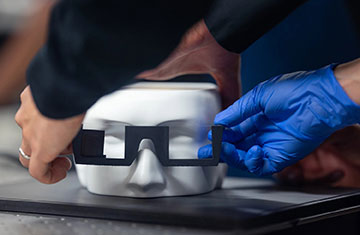
A prototype headset that resembles a pair of glasses can overlay life-like 3D images onto a direct view of the real world [Image: Andrew Brodhead]
A research team based at Stanford University, USA, has created a prototype system for augmented reality (AR) that exploits holographic imaging to overlay full-color, 3D moving images onto a headset that looks like a normal pair of glasses (Nature, doi: 10.1038/s41586-024-07386-0). By projecting the holograms through a nanostructured waveguide patterned onto the lenses of the headset, the researchers say their innovative approach delivers a visually satisfying 3D viewing experience in a compact and comfortable form factor.
Turning to holography
For AR systems, which superimpose virtual information onto the user's actual view of the outside world, the engineering challenge is to produce true-to-life 3D imagery within a slim and unobtrusive headset. Thin and transparent waveguides offer the most promising solution for the viewing optics, but existing systems still require the use of bulky projection lenses. Current designs also limit the digital content to two dimensions, which compromises the viewing experience and often causes eye fatigue or discomfort.
In contrast, the prototype developed at Stanford creates virtual images using small holographic displays at the edges of the headset, generating a full 3D volume without the need for other optical components. The images are then coupled into a waveguide formed by etching a nanostructure onto the surface of the lenses, creating a metasurface grating that confines and reflects the light.
In contrast, the prototype developed at Stanford creates virtual images using small holographic displays at the edges of the headset, generating a full 3D volume without the need for other optical components.
To enable full-color imaging, the lenses are made from a high-index glass that reflects all visible wavelengths along the waveguide. The geometry of the waveguide also reduces chromatic dispersion, with the thickness of the glass and the distance the light travels along the waveguide carefully engineered to enable red, green and blue wavelengths to complete one, three and five reflections before coming together for viewing by the user.
More accurate and realistic
The researchers also developed a novel computational approach to improve the visual quality of the final images, which would otherwise be degraded by small perturbations in the optical system. This combines a physically accurate waveguide model with a neural network that learns from real data captured by a camera, making it possible to correct for any deviations that might be caused, for example, by fabrication defects or optical aberrations.
Tests show that combining this AI-enhanced algorithm with the metasurface waveguide can deliver more accurate and realistic 3D images than have previously been demonstrated for an AR headset. The team is now looking at ways to improve the field of view, which, in common with other devices, is currently limited to around 12°, and to further reduce the thickness of the waveguide.
